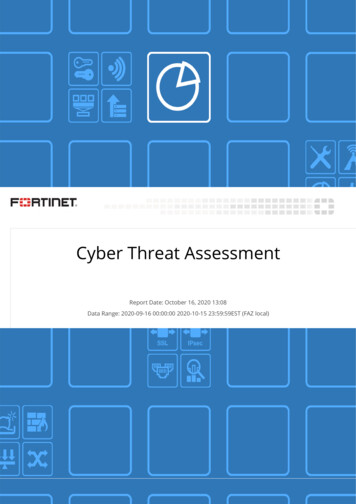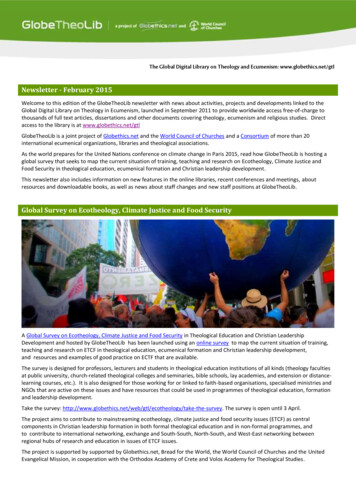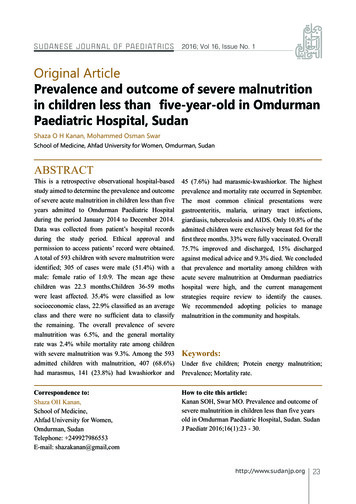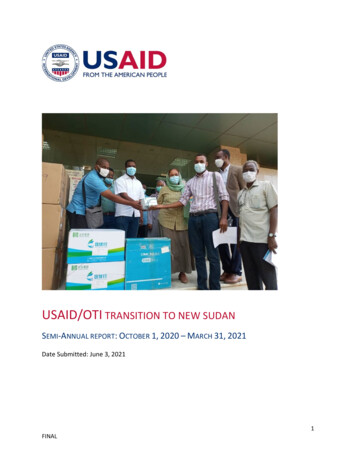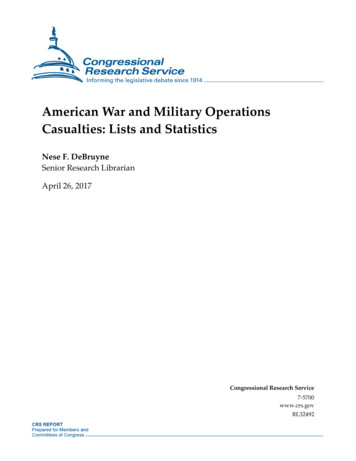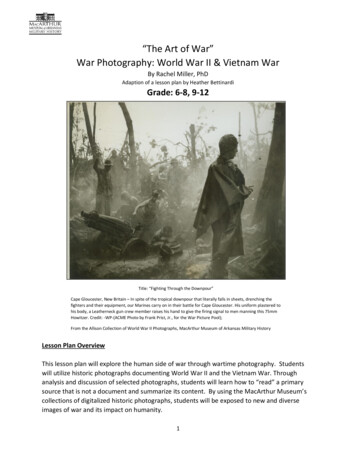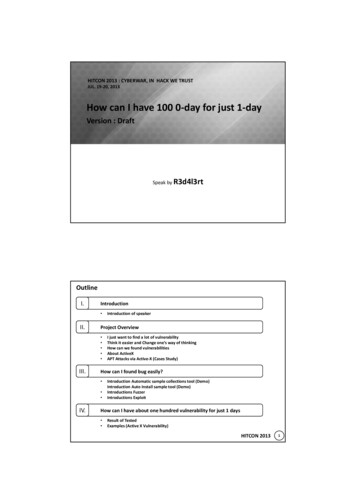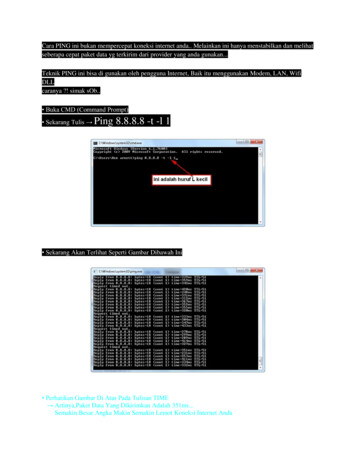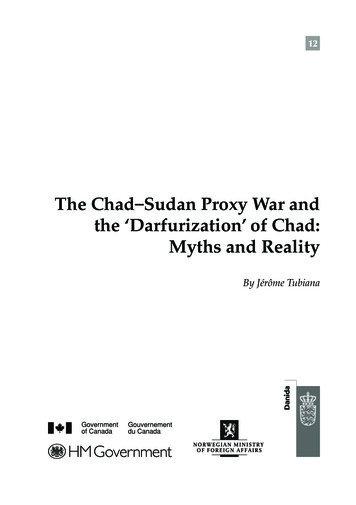
Transcription
12The Chad–Sudan Proxy War andthe ‘Darfurization’ of Chad:Myths and RealityBy Jérôme Tubiana
CopyrightThe Small Arms SurveyPublished in Switzerland by the Small Arms SurveyThe Small Arms Survey is an independent research project located at the Grad- Small Arms Survey, Graduate Institute of International Studies, Geneva 2008uate Institute of International Studies in Geneva, Switzerland. It serves as theprincipal source of public information on all aspects of small arms and as aFirst published in April 2008resource centre for governments, policy-makers, researchers, and activists.All rights reserved. No part of this publication may be reproduced, stored in aEstablished in 1999, the project is supported by the Swiss Federal Departmentretrieval system, or transmitted, in any form or by any means, without the priorof Foreign Affairs, and by contributions from the Governments of Belgium,permission in writing of the Small Arms Survey, or as expressly permitted byCanada, Finland, France, the Netherlands, Norway, Sweden, and the UK. Thelaw, or under terms agreed with the appropriate reprographics rights organi-Survey is also grateful for past and current project-specific support receivedzation. Enquiries concerning reproduction outside the scope of the above shouldfrom Australia, Denmark, and New Zealand. Further funding has been pro-be sent to the Publications Manager, Small Arms Survey, at the address below.vided by the United Nations Development Programme, the United NationsSmall Arms SurveyGraduate Institute of International Studies47 Avenue Blanc, 1202 Geneva, SwitzerlandCopyedited by Emily WalmsleyCartography by MAPgrafixTypeset in Optima and Palatino by Richard Jones, Exile: Design & EditorialServices (rick@studioexile.com)Printed by nbmedia in Geneva, SwitzerlandISBN 2-8288-0095-4Institute for Disarmament Research, the Geneva International Academic Network, and the Geneva International Centre for Humanitarian Demining. TheSmall Arms Survey collaborates with research institutes and NGOs in manycountries, including Brazil, Canada, Georgia, Germany, India, Israel, Jordan,Norway, the Russian Federation, South Africa, Sri Lanka, Sudan, Sweden,Thailand, the United Kingdom, and the United States.Small Arms SurveyGraduate Institute of International Studies47 Avenue Blanc, 1202 Geneva, SwitzerlandPhone: 41 22 908 5777Fax: 41 22 732 2738Email: smallarm@hei.unige.chWeb site: www.smallarmssurvey.org2Small Arms Survey HSBA Working Paper 12Tubiana The Chad–Sudan Proxy War and the ‘Darfurization’ of Chad3
The Human Security Baseline AssessmentContentsThe Sudan Human Security Baseline Assessment (HSBA) is a three-year researchAcronyms and abbreviations . 6project (2005–08) administered by the Small Arms Survey. It has been developedin cooperation with the Canadian Ministry of Foreign Affairs, the UN Missionin Sudan, the UN Development Programme, and a wide array of internationaland Sudanese NGO partners. Through the active generation and dissemination of timely empirical research, the HSBA project works to support disarma About the author . 7Abstract . 8I. Introduction . 10ment, demobilization, and reintegration (DDR), security sector reform (SSR),II. The ‘Darfurization’ of Chad?and arms control interventions to promote security.Background and current context . 14The HSBA is being carried out by a multidisciplinary team of regional, security,III. Historical and political context of the region . 20and public health specialists. It reviews the spatial distribution of armed violence throughout Sudan and offers policy-relevant advice to redress insecurity.HSBA Working Papers are timely and user-friendly reports on current researchactivities in English and Arabic. Future papers will focus on a variety of issues,including victimization and perceptions of security, armed groups, and localsecurity arrangements. The project also generates a series of Issue Briefs.The HSBA project is supported by Canada, the UK Government Global Conflict Prevention Pool, the Danish International Development Agency (Danida),and the Norwegian Ministry of Foreign Affairs.IV. Bilateral relations between Chad and Sudan . 24V. Armed groups in eastern Chad and Darfur . 32VI. The international response . 53VII. Conclusions: from peacekeeping to diplomacy . 57Appendix: Armed groups of Darfur and Chad . 62Endnotes . 70Bibliography . 75For more information contact:Claire Mc EvoyHSBA Project CoordinatorSmall Arms Survey, 47 Avenue Blanc1202 Geneva, SwitzerlandE-mail: mcevoy@hei.unige.chWeb site: www.smallarmssurvey.org/sudanHSBA Working Paper series editor: Emile LeBrun4Small Arms Survey HSBA Working Paper 12Tubiana The Chad–Sudan Proxy War and the ‘Darfurization’ of Chad5
Acronyms and abbreviationsAbout the authorANAlliance nationaleJérôme Tubiana (tubiana@gmail.com) holds a Ph.D. in African Studies from theANRAlliance nationale de résistanceInstitut national des langues et civilisations orientales (INALCO) in Paris. OverCARCentral African Republicthe past 12 years he has conducted more than ten research missions in northernCDRConseil démocratique revolutionnaireand eastern Chad, western Sudan, and eastern Niger, focusing on the TubuCNTConcorde nationale du Tchad (or Convention nationale du Tchad)(Teda–Daza) and Beri (Zaghawa and Bideyat) peoples. Since 2004, he hasEUFOREuropean Union ForceFPRNFront populaire pour la renaissance nationaleworked in Darfur and Chad as a researcher for various NGOs, most notablyFrolinatFront de libération nationale du TchadFSRFront pour le salut de la républiqueFUCFront uni pour le changementFUCDFront uni pour le changement démocratiqueJEMJustice and Equality MovementMPRDMouvement pour la paix, la reconstruction et le développementNMRDNational Movement for Reform and DevelopmentNRFNational Redemption FrontPDFPopular Defence ForcesRAFDRassemblement des forces démocratiquesRDLRassemblement pour la démocratie et les libertésRFCRassemblement des forces pour le changementRFIRadio France InternationaleRNDRassemblement national démocratiqueRNDPRassemblement national démocratique populaireRPJRassemblement populaire pour la justiceSCUDSocle pour le changement, l’unité et la démocratieSLASudan Liberation ArmyUFCDUnion des forces pour le changement et la démocratieUFDDUnion des forces pour la démocratie et le développementUFDD/FUFDD–FondamentaleUFDRUnion des forces démocratiques et du rassemblementUFPDUnion des forces pour le progrès et la démocratie6Small Arms Survey HSBA Working Paper 12Action contre la faim (ACF) and Médecins sans Frontières (MSF–France). Amongother publications, he has authored a field study on the causes and consequences of the Darfur crisis (‘Le Darfour: un conflit identitaire,’ Afrique Contemporaine, No. 214, 2005), a study on the issue of land in Darfur (‘Darfur: aconflict for land,’ in War in Darfur and the Search for Peace, edited by Alex deWaal, Harvard University, 2007), a study of Darfur rebels (Divided They Fall:The Fragmentation of Darfur’s Rebel Groups, with Victor Tanner, Small ArmsSurvey, 2007), and a book of Teda–Daza and Beri tales (Contes Toubou du Sahara,L’Harmattan, 2007). As a freelance journalist and photographer, he has alsowritten for a number of French newspapers and publications on Chad and theHorn of Africa.Tubiana The Chad–Sudan Proxy War and the ‘Darfurization’ of Chad7
Abstract The contention that the Darfurian conflict is being ‘exported’ to eastern Chad via janjawid militia has received widespread coverage. However, this is a dan gerous oversimplification of the ethnic and political dynamics of the region,and most especially neglects the importance of the political crisis in Chad.Khartoum and N’Djamena have been engaged in an on-again, off-again proxyconflict using one another’s rebel movements since the Darfur conflict beganin 2003, most intensively since 2005. Khartoum has attempted on multiple occasions to unify the Chadian rebel groups to destabilize or even overthrowthe Déby regime. While Déby has survived two attacks on the capital, he has managed to hold on to power through repression and incentives to those who rally to him. This Working Paper provides the contextual and historical background for understanding the current Chad–Sudan conflict, its complex ethniccomponents, and the history of the Chadian rebel factions. The paper explains both legal and armed—and the Déby regime to the negotiating table. Small Arms Survey HSBA Working Paper 12 8 why the current international peacekeeping effort is unlikely to be successfulwithout an accompanying diplomatic push to bring the Chadian opposition— Tubiana The Chad–Sudan Proxy War and the ‘Darfurization’ of Chad9
I. IntroductionThis Sudanese support featured again in the last rebel raid on N’Djamena,which was defeated outright thanks to Déby’s superiority in arms (helicopters and tanks), some support from France and Libya, and the rebels’ lack ofpreparation for urban warfare, their limited fuel and ammunitions, and theirpersistent ethnic divisions and personal rivalries. On 2 February 2008, whenThe current far-reaching conflict in Darfur extends well beyond the bordersthe rebels entered the Chadian capital, many people among both rebel andof Sudan, particularly into Chad. Efforts by the Chadian government to avoidgovernment forces—by then suffering numerous defections—the civilian pop-taking sides in the conflict were shattered in 2003–04 by the arrival of someulation, and the international community had given up Déby’s regime for dead,200,000 Sudanese refugees across the border and the establishment of rear basesafter 17 years in power. The day before, the Chadian Army and the presidentin eastern Chad by Darfurian rebel groups. The rebels were strengthened byhimself had been defeated in Massaguett, only 50 kilometres north-east oftheir membership of cross-border ethnic groups, including the Beri (Zaghawaand Bideyat), to which the Chadian president Idriss Déby belongs. Déby’sinability to control his Beri kinsmen, including those closest to him, broughtan end to more than ten years of good relations with the Sudanese regime ofOmar al-Bashir. Subsequently, violence similar to that in Darfur began emerging in eastern Chad: attacks on villages, mainly non-Arab ones, by militiasknown as the janjawid, who recruit largely (though not solely) from nomadicArab groups. This has caused the internal displacement of more than 170,000Chadian civilians.Some of the perpetrators of this violence have links with Darfur: some ofthe janjawid active in Chad appear to be the same as those active on the western border of Darfur, who are supported by the Sudanese government andrecruit from both Sudanese and Chadian Arab groups. But more than thejanjawid in Darfur, those in Chad also recruit from non-Arab communities,whose motivation comes mostly from local conflicts for land with other nonArabs, which are similar but not related to the land conflicts in Darfur (Tubiana,N’Djamena, and retreated to the capital after an hour of fighting. The rebelshad travelled the breadth of Chad from east to west in less than a week, havingcrossed the border from West Darfur in the area of Adé, south of Geneina. Theyhad driven fast, avoiding the government forces concentrated in the east, andgathered a force of around 4,000 fighters mounted on some 300 pick-ups, whichhad mostly been given, together with arms, by the Sudanese government. It wasnot the first time Khartoum was arming Chadian rebel groups, in particularthe three main ones: Union des forces pour la démocratie et le développement(UFDD), UFDD–Fondamentale (UFDD/F), and Rassemblement des forces pourle changement (RFC). But once again the Sudanese regime had failed to unifythem, and the rebels’ joint military command proved ineffectual.The attack on N’Djamena challenges yet again the international community’sfailure to address the central issues in the Chad–Darfur crisis: the first is theproxy war between Chad and Sudan, the roots of which lie in Darfur and inthe lack of political freedom in Déby’s regime; the second is the ongoing Frenchsupport for this regime, which says as much about traditional French politics asabout the possibility of the Darfur conflict spilling over into Chad. Although2006b; Tubiana, 2007). The violence in eastern Chad has roots in the aggrava-French support is not the main factor behind Déby’s survival in the most recenttion of these local conflicts between communities, as well as in the weaknessattack,1 it could now become more open in its provision of French troops toof Chadian institutions and the Chadian people’s widespread frustrationfight the rebels. On 4 February 2008, following a proposal by the French gov-with the country’s unequal wealth distribution—particularly its oil wealth—ernment, the UN Security Council adopted a declaration (not a resolution, asand lack of democracy. The same factors have also led to an increase in theFrance originally wished) condemning the rebels and asking member statespower of the rebel groups in Chad, who, thanks to the cooling in Chad–Sudanto support Chad. On the one hand, this satisfied the long-standing French aimrelations, have been supported directly by Khartoum since 2005.to ‘multilateralize’ its support for the Chadian regime (although it is unlikely10Small Arms Survey HSBA Working Paper 12Tubiana The Chad–Sudan Proxy War and the ‘Darfurization’ of Chad11
that many countries other than France will fight the rebels alongside theinated by attempts to negotiate between the Sudanese and Chadian govern-Chadian Army). But on the other hand, it posed a challenge to another recentments, and between these governments and their respective rebel move-attempt to multilateralize the Chadian issue: the establishing of a Europeanments. The peacekeeping operations and negotiations will only be successful,Union peacekeeping force (EUFOR) expected to arrive in eastern Chad in thehowever, if the peacekeepers—particularly EUFOR—prove to be sufficientlycoming months. The neutrality of this force is more and more in question givenneutral, if the international community continues to put pressure on thethe pre-eminence of French troops in its ranks.different armed actors to take part, and if these negotiations open up to non-This Working Paper finds that: The simplification of the situation in Chad, in particular by the media, ignoresarmed actors—the political opposition and civil society—and incorporatefundamental issues of the democratic process in both Chad and Sudan.some of the key factors that explain the violence. This has been exploitedby the Chadian and French governments and by other players in the conflict.The present violence is often characterized as attacks by the janjawid—alwaysportrayed as Arab and always as Sudanese—on the non-Arab civilian populations in Chad, and as attacks by Chadian rebel movements supposedlyfollowing orders from Khartoum. This presents the situation as a directexportation of the Darfur conflict into Chad, or the ‘Darfurization’ of thecountry, without paying enough attention to the existence of a political crisisin Chad itself.2 It will not be possible to resolve the conflict in Darfur without involving thewhole region—particularly Chad, the Central African Republic (CAR), andother neighbours of Sudan. The complexity of the ethnic links across bordersand the tormented history of Chad–Sudanese relations since the former’sindependence in 1960 are central to understanding how the conflicts in Darfurand Chad influence each other, without being totally interdependent. Sudan and Chad have been in conflict via rebel groups and proxy militiasintensively since the end of 2005. Attempts by both states, however, to setup rebel coalitions under their control have failed, leaving the field open to amultitude of armed factions, which are increasingly local and increasinglydivided along ethnic lines, aggravating the security situation even further. The international response to the crises in Darfur and Chad is currently basedon the dispatch of peacekeeping forces: 26,000 men, under the aegis of theUnited Nations and the African Union, are being sent to Darfur itself; and3,700 men comprising the EUFOR troops are being sent to Chad and theCAR. The diplomatic process is still in its infancy and so far has been dom12Small Arms Survey HSBA Working Paper 12Tubiana The Chad–Sudan Proxy War and the ‘Darfurization’ of Chad13
II. The ‘Darfurization’ of Chad? Backgroundand current contextthe Front uni pour le changement démocratique (FUCD), attempted a firstlightning raid on N’Djamena, which the Chadian government only halted atthe last minute with French support. Since then, tensions between the twostates have continued to rise. In April 2007, the Chadian Army itself enteredSudanese territory and confronted troops from Khartoum. And in January 2008,Chadian planes bombed Chadian rebel positions in West Darfur. ThroughoutThe Dar Sila region of south-eastern Chad has been raided by janjawid militias2006 and 2007, however, it was mainly the rebel groups in Darfur who, onsince the conflict in Darfur began in 2003. The raids intensified at the end ofseveral occasions, fought rebel groups from Chad alongside the Chadian Army,2005 when the international community became aware that Chad might be-in Chadian territory. Sudan and Chad have thus become embroiled in a proxy3come ‘contaminated’ by Darfur’s violence. Fighting has taken place betweenwar through various rebel movements and auxiliary militias.these militias and the rebels in Darfur, for whom Dar Sila is one of their rearThe identification of these movements and militias is not simple. In Chad,bases in Chad. But as in Darfur, the janjawid mostly attack the non-Arab civil-all of the rebels from Darfur, and sometimes also the non-Arab (mostly Dajo)ians in the region, particularly the Dajo, who hold the sultanate of Dar Sila.militias who fight against the janjawid, are referred to as the ‘Toro Boro’, irre-And as in Darfur, villages are burnt, cattle and goods stolen, and the civilianspective of the faction to which they belong. This term is imported from Darfur,population forced to flee from their lands. By February 2008 more than 170,000where ‘Tora Bora’ or ‘Toro Boro’ is the nickname given to and adopted by thepeople had been displaced inside Chad, mainly in Dar Sila, in fewer than twoDarfur rebels, especially the Sudan Liberation Army (SLA), as a reference toyears and are now dependent on international humanitarian aid. In a shortthe mountains in Afghanistan where Osama bin Laden survived intensiveperiod of time, then, the symptoms of the crisis in Darfur have been exportedUS bombing. In 2003–04, SLA fighters were similarly bombed by Khartoum’sto south-eastern Chad, and to some extent to the CAR.planes while they were hiding in Darfur’s mountains. This general nicknameThe primary reason for the spread of the conflict from Darfur is the perme-does not, however, give any indication of the number of rebel factions inability of the 600 kilometre Chad–Sudan border. Several ethnic groups live onDarfur, nor the fact that not all are supported by Chad and only some fighteither side of what, for them, is simply a line on the map. This is particularlyalongside the Chadian Army. Similarly, identifying the janjawid who are activetrue of the Beri—who are better known by their Arabic names of Zaghawa andin Chad in terms of ethnicity and nationality (Arab or non-Arab? Chadian orBideyat—a people who play a central role in both countries (Tubiana, 1977;Sudanese, or both?) is very difficult.Tubiana, 2006a). The president of Chad, Idriss Déby, is a member of this group,Although the janjawid militias in Chad are largely autonomous—much moreas are some of the leading rebel chiefs in Darfur (Tanner and Tubiana, 2007).so than the Sudanese janjawid, who are mainly Khartoum-backed militiasDéby has long maintained relations with the government in Khartoum, butfighting together with the army and often officially integrated in paramilitaryhas never been able to prevent those close to him from supporting the rebelsforces—they appear to have benefited from Sudanese support, the extent ofin Darfur. As one of them explained in 2006: ‘The Sudanese think that as longwhich is hard to determine. Not all combatants in these militias were recruitedas we, the Zaghawa, are in power in Chad, they will never end the rebellion.in Sudan, but many appear to obey the same leaders as the janjawid in West4What they want is regime change in N’Djamena.’Darfur, who have been armed for more than ten years by the Sudanese gov-In 2004, and particularly from the end of 2005, Khartoum began actively toernment in their attacks on non-Arab villages. Indeed, the Arab leaders fromsupport various groups of Chadian rebels based in Darfur. In April 2006, oneWest Darfur—such as Amir Hamid ad-Daway and Amir Abdallah Abuof the groups, the Front uni pour le changement (FUC), sometimes also calledShinebat—are regularly cited as commanders of the janjawid active in both14Small Arms Survey HSBA Working Paper 12Tubiana The Chad–Sudan Proxy War and the ‘Darfurization’ of Chad15
West Darfur and Chad. In the 1990s, some of these leaders, who mostly orig-created the European Union Force (EUFOR) Chad/CAR, which is expectedinated from Chad, were appointed as traditional leaders by the Sudaneseto include 3,700 troops.government and given the title of amir (a term meaning prince in Arabic, thatFrom the very beginning, however, those advocating the deployment of anwas used in Sudan for the Mahdist military chiefs of the 19 century and sinceinternational force in Chad have been divided. The Chadian government appar-the 1990s for Darfur Arab traditional leaders, many of whom happen also toently sees it as additional protection, strengthening the usual French support,be military chiefs). Sudanese uniforms are now worn both by the militias activesparing its own forces the cost of protecting civilians, and allowing them toin Chad and by the Chadian rebels, providing a more visible sign of Khartoum’sconcentrate on fighting the rebels instead. Déby admitted this explicitly inthsupport.5February 2008 during an interview on the French radio station Europe 1 regard-The janjawid and the Chadian rebels do not necessarily employ the sameing the recent attack on N’Djamena:methods, nor have the same motivations, but their attacks often coincide. Thus,at the beginning of November 2006, the first attacks of the Union des forces‘It would have helped us if EUFOR had been already in Chad, because I would havepour la démocratie et le développement (UFDD)—the new rebel coalitionhad the possibility to dismantle units at the border. . . [EUFOR will] free us of thesupported by Khartoum—in Dar Sila and Salamat were followed by violentweight of being responsible for the security of 300,000 Sudanese refugees and 170,0006janjawid attacks in the two regions. This can be partly explained by the factChadian IDPs. It is a significant burden that mobilizes many of our forces.’ 9that, in order to defend themselves against the highly mobile rebels, the government in Chad preferred to concentrate its forces around the main towns,especially the capital, leaving regions such as Dar Sila without any defence.His minister of foreign affairs, Ahmat Allam-Mi, declared in a press conference the same month:Occasionally, janjawid forces and Chadian rebels have fought together. InMarch 2007, for example, the Concorde nationale du Tchad (also known as‘We wish to have good relations with our neighbours [Sudan]. This is why wethe Convention nationale du Tchad) (CNT) took part alongside janjawid forceshesitated a lot before accepting this force. . . EUFOR will be able to discouragein a violent attack on the villages of Tiero and Marena, in Dar Sila, in whichrebels coming from Sudan and to discourage Sudan itself from attacking Chad. . . .7200–400 Dajo civilians and militiamen were killed. Furthermore, certain lead-EUFOR will be an unsettling witness, another open window on Darfur alongsideers and Chadian rebel combatants (particularly Mahamat Nour Abdelkarim)the International Criminal Court, which will shake up Khartoum’s regime.’10were part of the auxiliary forces of the Sudanese government in West Darfurat the beginning of the conflict and have maintained contacts with the West8Darfurian janjawid.One of the objectives of the rebel attacks in eastern Chad has been to destabilize the regime in N’Djamena, but Déby has managed to turn the situationThis expected role of EUFOR contradicts its mandate, which does not include protecting the border from rebel attacks;11 similarly it is not tasked withaddressing events in Darfur, or arresting criminals indicted by the InternationalCriminal Court.to his advantage. In November 2006, the Chadian government used the vio-On the other hand, the first EUFOR promoters are human rights organiza-lence provoked by the rebels as a pretext to order a state of emergency intions—particularly Human Rights Watch, which has recommended a solutionmost of its territory, even though the violence was localized. The attacks haveof this type since February 2006—hoping that this force will protect local peo-also allowed the regime to renew its request for an international force to policeple against the incursions of the janjawid militias from Darfur, and even avoidits eastern border (UN, 2006). Resolution 1778, adopted unanimously by thethe Darfurization of Chad as a whole (Human Rights Watch, 2006). Prior toUnited Nations Security Council on 25 September 2007, has subsequentlythe recommendations of Human Rights Watch, leaders of other organizations16Small Arms Survey HSBA Working Paper 12Tubiana The Chad–Sudan Proxy War and the ‘Darfurization’ of Chad17
(such as Physicians for Human Rights) were insisting on the need to protectFinally, Chadian rebels may be backed by Khartoum but they have their ownChad from the risk of destabilization in order to avoid an extension of themotivations and agenda. If they were to take power, they would not neces-Darfur crisis (Heffernan and Johnson, 2005). More recently, this analysis hassarily become stooges of the Sudanese government or allow it to install abeen taken up in diplomatic circles in order to justify French and UN supportpuppet regime.for Déby’s regime after the rebel attack of 2 February. Anonymous diplomatsquoted by a French newspaper argued that Déby’s fall would be ‘catastrophic’for Darfur, to the extent that the deployment of the United Nations–AfricanUnion Mission in Darfur (UNAMID) would have to be aborted.12 Some eventalk about a risk of Muslim fundamentalism spilling over from Sudan intoChad (Bernard et al., 2008), but this is both anachronistic—it is well-knownthat Omar al-Bashir’s regime gave up its Islamic expansionist agenda to breakits international isolation years ago—and unlikely to happen: it did not, afterall, occur during the many years in which Déby was a close ally of a much moreexpansionist Sudanese regime.These analyses of the potential Darfurization of Chad are widely knownand broadcast by the news media, but they can be challenged on several points.First, although Chad has at times been depicted as a centre of stability in theregion, it has often played a destabilizing role in Darfur—dividing the rebels,intentionally or not—and in the CAR. Second, if there is a real risk of Chadbecoming ‘Darfurized’ then the exact meaning of this term needs to be considered. If, for example, it is implying that a general war between Arab andnon-Arab could develop throughout Chad
8 Small Arms Survey HSBA Working Paper 12 Tubiana The Chad-Sudan Proxy War and the 'Darfurization' of Chad 9 Abstract The contention that the Darfurian conflict is being 'exported' to eastern Chad via janjawid militia has received widespread coverage. However, this is a dan-gerous oversimplification of the ethnic and political dynamics of the region,


